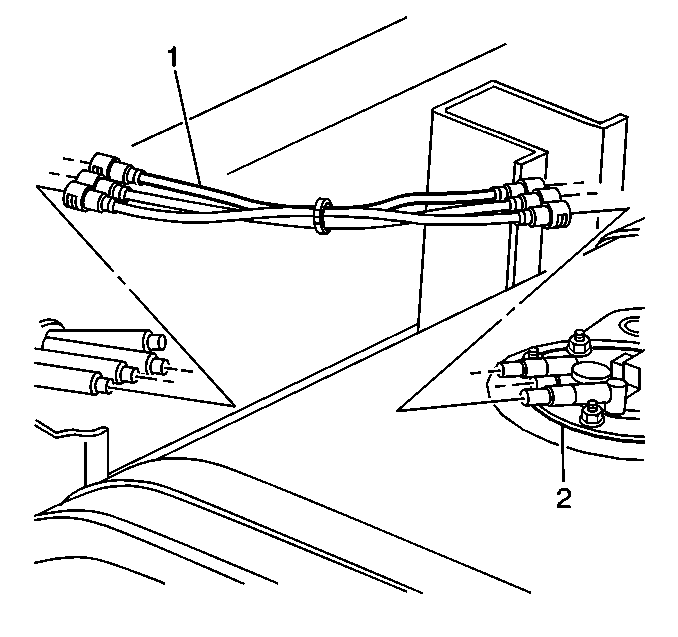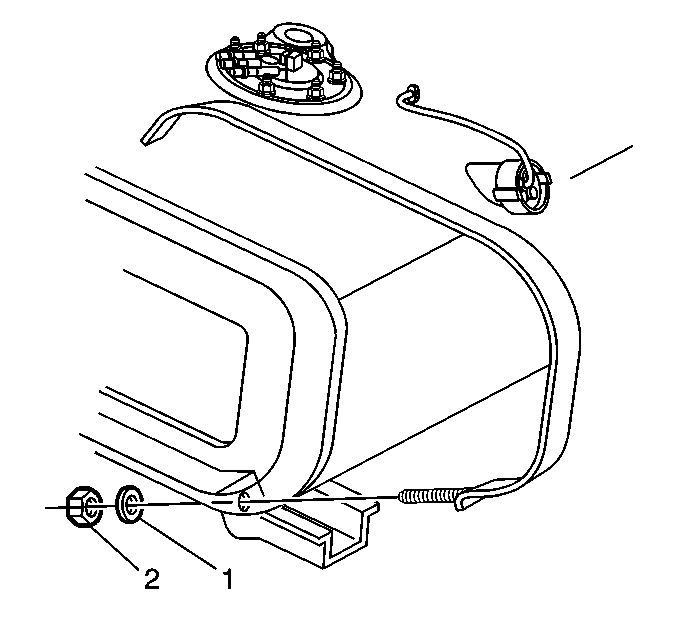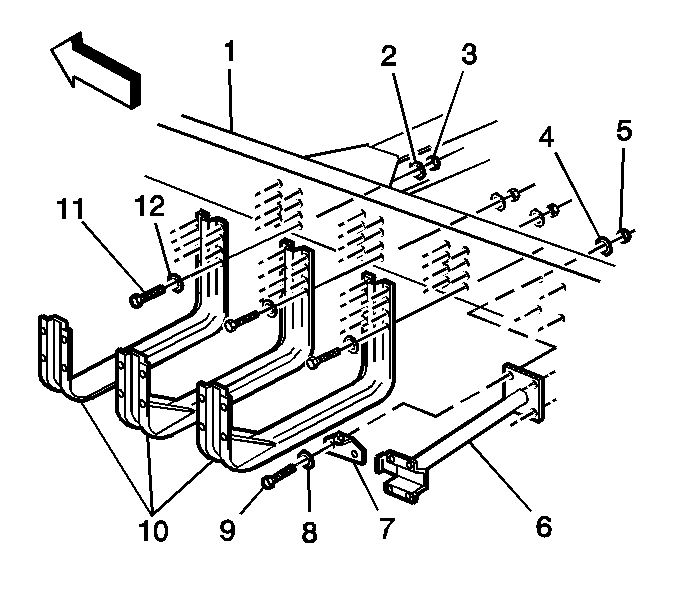Removal Procedure
- Remove the negative battery cable.
- Relieve the fuel system pressure. Refer to Fuel Pressure Relief .
- Remove the fuel from tank. Refer to Fuel Tank Draining .
- Remove the sender assembly electrical connector.
- Remove the fuel feed and return pipe quick-connect fittings at fuel sender assembly. Refer to Metal Collar Quick Connect Fitting Service and Plastic Collar Quick Connect Fitting Service
- Remove the vent hose assembly (1) from both vent valves (2).
- Remove the fuel tank strap nuts (2) and washers (1).
- Remove the rear brace to frame attaching hardware.
- Remove the rear brace.
- Slide the tank back on to a suitable lifting device.
- Remove the tank.
- Remove the six nuts and washers retaining the fuel sender (2) assembly lock ring.
- Remove the lock ring, sender assembly, and seal. Refer to Fuel Sender Assembly Replacement .
- Purge the tank if it is being serviced. Refer to Fuel System Cleaning .
Caution: Unless directed otherwise, the ignition and start switch must be in the OFF or LOCK position, and all electrical loads must be OFF before servicing any electrical component. Disconnect the negative battery cable to prevent an electrical spark should a tool or equipment come in contact with an exposed electrical terminal. Failure to follow these precautions may result in personal injury and/or damage to the vehicle or its components.

Raise and secure the vent hose assembly.

Raise and secure the straps.

Discard the old seal.
Installation Procedure
- Install the new seal, sender assembly, and lock ring. Refer to Fuel Sender Assembly Replacement .
- Install the six nuts and washers retaining the fuel sender assembly lock ring (2).
- Install the fuel tank into support brackets.
- Install the fuel tank staps,nuts, (2) and washers, (1).
- Place the fuel tank on suitable lifting device. Raise the fuel tank and slide into position.
- Install the support bracket bolts, (11) nuts, (3) and washers (2,12) to frame (1).
- Install the front brace attaching hardware.
- Reconnect the vent hose assembly to both vent valves.
- Reconnect the fuel sender assembly electrical connector.
- Fill the tank with fuel.
- Reconnect the negative battery cable.
- Inspect the fuel lines for leaks.
Make sure the alignment tab on the fuel sender assembly meets the tab opening in the locking ring.
Notice: Use the correct fastener in the correct location. Replacement fasteners must be the correct part number for that application. Fasteners requiring replacement or fasteners requiring the use of thread locking compound or sealant are identified in the service procedure. Do not use paints, lubricants, or corrosion inhibitors on fasteners or fastener joint surfaces unless specified. These coatings affect fastener torque and joint clamping force and may damage the fastener. Use the correct tightening sequence and specifications when installing fasteners in order to avoid damage to parts and systems.

Tighten
Tighten the nuts to 11.5 N·m (100.90 lb in).
Tighten
Tighten the nuts to 24 N·m (18 lb ft).

Tighten
Tighten the nuts to 77.5 N·m (57 lb ft).

Reconnect the fuel feed, the return, the vent, and the vapor pipes (1) quick connect fitting to fuel sender assembly (2).
Caution: Unless directed otherwise, the ignition and start switch must be in the OFF or LOCK position, and all electrical loads must be OFF before servicing any electrical component. Disconnect the negative battery cable to prevent an electrical spark should a tool or equipment come in contact with an exposed electrical terminal. Failure to follow these precautions may result in personal injury and/or damage to the vehicle or its components.
| 12.1. | Turn ON the ignition switch for two seconds. |
| 12.2. | Turn OFF the ignition switch for ten seconds. |
| 12.3. | Turn ON the ignition switch in order to check for leaks. |
